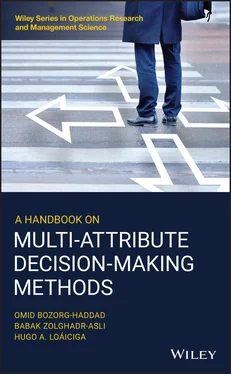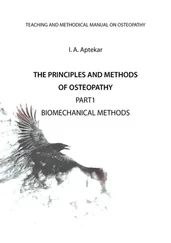1 Cover
2 Wiley Series in Operations Research and Management Science
3 Title Page
4 Copyright
5 Preface
6 1 An Overview of the Art of Decision‐making1.1 Introduction 1.2 Classification of MADM Methods 1.3 Brief Chronicle of MADM Methods 1.4 Conclusion References
7 2 Simple Weighting Methods: Weighted Sum and Weighted Product Methods2.1 Introduction 2.2 The Weighted Sum Method 2.3 The Weighted Product Method 2.4 Conclusion References
8 3 Analytic Hierarchy Process (AHP)3.1 Introduction 3.2 The Hierarchical Structure 3.3 The Pairwise Comparison 3.4 Inconsistency 3.5 Quadruple Axioms of the AHP 3.6 Stepwise Description of the AHP Method 3.7 Conclusion References
9 4 Analytic Network Process (ANP)4.1 Introduction 4.2 Network Vs. Hierarchy Structure 4.3 Stepwise Instruction to the ANP Method 4.4 Conclusion References
10 5 The Best–Worst Method (BWM)5.1 Introduction 5.2 Basic Principles of the BWM 5.3 Stepwise Description of the BWM 5.4 Conclusion References
11 6 TOPSIS6.1 Introduction 6.2 Stepwise Description of the TOPSIS Method 6.3 A Common Misinterpretation of TOPSIS Results 6.4 Conclusion References
12 7 VIKOR7.1 Introduction 7.2 Stepwise Description of the VIKOR Method 7.3 Conclusion References
13 8 ELECTRE8.1 Introduction 8.2 A Brief History of the ELECTRE Family of Methods 8.3 ELECTRE I 8.4 ELECTRE II 8.5 ELECTRE III 8.6 ELECTRE IV 8.7 Conclusion References
14 9 PROMETHEE9.1 Introduction 9.2 Common Ground of the PROMETHEE Family 9.3 PROMETHEE I 9.4 PROMETHEE II 9.5 PROMETHEE III 9.6 PROMETHEE IV 9.7 Conclusion References
15 10 Superiority and Inferiority Ranking (SIR)10.1 Introduction 10.2 Foundational Bases of the SIR Method 10.3 Stepwise Description of the SIR Method 10.4 Conclusion References
16 11 PAPRIKA11.1 Introduction 11.2 Stepwise Description of PAPRIKA 11.3 Conclusion References
17 12 Gray Relational Analysis12.1 Introduction 12.2 Gray System Theory: The Foundation and Basic Principles 12.3 Gray Relational Modeling 12.4 Gray Theory in Relation to MADM 12.5 Conclusion References
18 A Weight Assignment Approaches Subjective Approach: Weighted Least Squares Objective Approach: Multiobjective Programming Model References
19 B A Benchmark Example and a Comparison between Objective‐ and Subjective‐Based MADM Methods References
20 Index
21 End User License Agreement
1 Chapter 1 Table 1.1 Comparison of MODM and MADM approaches. Table 1.2 A chronologic overview of the most influential MADM methods.
2 Chapter 3Table 3.1 A typical pairwise comparison scale for the AHP method.Table 3.2 The random index value for matrices of different orders.
3 Chapter 4Table 4.1 The fundamental scale for pairwise comparisons.Table 4.2 The random index value for pairwise comparison matrices of different orders. Source: Modified from Tzeng and Huang (2011).
4 Chapter 5Table 5.1 A typical pairwise comparison scale for the BWM. Source: Saaty (1977, 1980) and Rezaei et al. (2015).Table 5.2 The inconsistency index ( ξ *) of 1–9 scale.
5 Chapter 8Table 8.1 The guideline for the exploitation stage of ELECTRE I.
6 Chapter 9Table 9.1 The recommended preference functions for the family of PROMETHEE methods.Table 9.2 The definition of the parameters used in the tuning of the PROMETHEE family.Table 9.3 The types of conditions for pairs of alternatives in the family of PROMETHEE methods.Table 9.4 Conditional assessments used in the PROMETHEE I method.Table 9.5 Conditional assessments used in the PROMETHEE II method.Table 9.6 Conditional assessments used in the PROMETHEE III method.
7 Chapter 10Table 10.1 The recommended types of modified preference functions for the SIR method.Table 10.2 The definition of the parameters used in the tuning of the SIR method.Table 10.3 Conditional assessments used in the SIR method.
8 Appendix BTable B.1 The separation measures for the set of alternatives.Table B.2 The relative closeness to the ideal solutions and the ranking of the alternatives according to the TOPSIS method.Table B.3 The aggregated scores and ranking of the alternatives according to the AHP method.
1 Chapter 3 Figure 3.1 A scheme of hierarchical structure of an MADM problem.
2 Chapter 4Figure 4.1 The forms of connection in the structure of a network, (a) linear connection, (b) cyclic connection, and (c) loop connection.Figure 4.2 The forms of components in the structure of a network, (a) source component, (b) sink component, and (c) intermediate component. Source: Modified from Saaty (1996)
3 Chapter 7Figure 7.1 The general scheme of an MADM problem with two positive criteria c 1and c 2
1 Cover
2 Contents
3 Begin Reading
1 ii
2 iii
3 v
4 vi
5 xiii
6 xiv
7 1
8 2
9 3
10 4
11 5
12 6
13 7
14 8
15 9
16 10
17 11
18 12
19 13
20 14
21 15
22 17
23 18
24 19
25 20
26 21
27 22
28 23
29 24
30 25
31 26
32 27
33 28
34 29
35 30
36 31
37 32
38 33
39 34
40 35
41 36
42 37
43 38
44 39
45 40
46 41
47 42
48 43
49 44
50 45
51 46
52 47
53 48
54 49
55 50
56 51
57 52
58 53
59 54
60 55
61 56
62 57
63 59
64 60
65 61
66 62
67 63
68 64
69 65
70 66
71 67
72 68
73 69
74 70
75 71
76 72
77 73
78 74
79 75
80 76
81 77
82 78
83 79
84 80
85 81
86 82
87 83
88 84
89 85
90 86
91 87
92 88
93 89
94 90
95 91
96 92
97 93
98 94
99 95
100 96
101 97
102 98
103 99
104 100
105 101
106 102
107 103
108 104
109 105
110 106
111 107
112 108
113 109
114 110
115 111
116 112
117 113
118 114
119 115
120 116
121 117
122 118
123 119
124 120
125 121
126 122
127 123
128 125
129 126
130 127
131 128
132 129
133 130
134 131
135 132
136 133
137 134
138 135
139 136
140 137
141 138
142 139
143 140
144 141
145 142
146 143
147 144
148 145
149 146
150 147
151 148
152 149
153 150
154 151
155 152
156 153
157 154
158 155
159 156
160 157
161 159
162 160
163 161
164 162
165 163
166 164
167 165
168 167
169 168
170 169
171 170
172 171
173 173
174 174
175 175
176 176
Wiley Series in Operations Research and Management Science
Operations Research and Management Science (ORMS) is a broad, interdisciplinary branch of applied mathematics concerned with improving the quality of decisions and processes and is a major component of the global modern movement toward the use of advanced analytics in industry and scientific research. The Wiley Series in Operations Research and Management Science features a broad collection of books that meet the varied needs of researchers, practitioners, policy makers, and students who use or need to improve their use of analytics. Reflecting the wide range of current research within the ORMS community, the Series encompasses application, methodology, and theory and provides coverage of both classical and cutting edge ORMS concepts and developments. Written by recognized international experts in the field, this collection is appropriate for students as well as professionals from private and public sectors including industry, government, and nonprofit organization who are interested in ORMS at a technical level. The Series is comprised of four sections: Analytics; Decision and Risk Analysis; Optimization Models; and Stochastic Models.
Читать дальше












